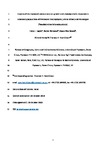Impacts of the mycotoxin zearalenone on growth and photosynthetic responses in laboratory populations of freshwater macrophytes (Lemna minor) and microalgae (Pseudokirchneriella subcapitata).
| dc.contributor.author | Eagles, Emily | |
| dc.contributor.author | Benstead, R | |
| dc.contributor.author | MacDonald, S | |
| dc.contributor.author | Handy, Richard | |
| dc.contributor.author | Hutchinson, Tom | |
| dc.date.accessioned | 2019-01-24T17:29:11Z | |
| dc.date.issued | 2019-03 | |
| dc.identifier.issn | 0147-6513 | |
| dc.identifier.issn | 1090-2414 | |
| dc.identifier.uri | http://hdl.handle.net/10026.1/13222 | |
| dc.description.abstract |
Mycotoxins are an important class of chemicals of emerging concern, recently detected in aquatic environments, potentially reflecting the influence of fungicide resistance and climatic factors on fungal diseases in agricultural crops. Zearalenone (ZON) is a mycotoxin formed by Fusarium spp. and is known for its biological activity in animal tissues; both in vitro and in vivo. ZON has been reported in US and Polish surface waters at 0.7 - 96 ng/L, with agricultural run-off and wastewater treatment plants being the likely sources of mycotoxins. As some mycotoxins can induce phytotoxicity, laboratory studies were conducted to evaluate the toxicity of ZON (as measured concentrations) to freshwater algae (Pseudokirchneriella subcapitata) and macrophytes (Lemna minor) following OECD test guidelines 201 and 221, respectively. Zinc sulphate was used as a positive control. In the OECD 201 algal static study (72 h at 24 ± 1 °C), exposure to ZON gave average specific growth rate (cell density) EC50 and yield (cell density) EC50 values of > 3.1 and 0.92 (0.74 - 1.8) mg/L, respectively. ZON was less toxic in the OECD 221 static study and after 7 d at 24 ± 1 °C. L. minor growth was significantly reduced based on frond number and frond area at 11.4 mg ZON/L, showing a higher tolerance than reported for other mycotoxins with Lemna spp. Chlorophyll fluorescence parameters were used as biomarkers of impacts on photosystem II efficiency, with no effect seen in algae but, with responses being observed in L. minor between 5.2 - 14.4 mg ZON/L. ZON toxicity seen here is not of immediate concern in context with environmental levels, but this study highlights that other freshwater organisms including algae are more sensitive to mycotoxins than Lemna sp., the only current source of toxicity data for freshwater plants. | |
| dc.format.extent | 225-231 | |
| dc.format.medium | Print-Electronic | |
| dc.language | en | |
| dc.language.iso | en | |
| dc.publisher | Elsevier | |
| dc.subject | Emerging chemical | |
| dc.subject | Fungal toxin | |
| dc.subject | Phytotoxicity | |
| dc.subject | Risk assessment | |
| dc.title | Impacts of the mycotoxin zearalenone on growth and photosynthetic responses in laboratory populations of freshwater macrophytes (Lemna minor) and microalgae (Pseudokirchneriella subcapitata). | |
| dc.type | journal-article | |
| dc.type | Journal Article | |
| plymouth.author-url | https://www.ncbi.nlm.nih.gov/pubmed/30448705 | |
| plymouth.volume | 169 | |
| plymouth.publication-status | Published | |
| plymouth.journal | Ecotoxicology and Environmental Safety | |
| dc.identifier.doi | 10.1016/j.ecoenv.2018.10.101 | |
| plymouth.organisational-group | /Plymouth | |
| plymouth.organisational-group | /Plymouth/Faculty of Science and Engineering | |
| plymouth.organisational-group | /Plymouth/Faculty of Science and Engineering/School of Biological and Marine Sciences | |
| plymouth.organisational-group | /Plymouth/REF 2021 Researchers by UoA | |
| plymouth.organisational-group | /Plymouth/REF 2021 Researchers by UoA/UoA06 Agriculture, Veterinary and Food Science | |
| plymouth.organisational-group | /Plymouth/Research Groups | |
| plymouth.organisational-group | /Plymouth/Research Groups/BEACh | |
| plymouth.organisational-group | /Plymouth/Research Groups/Marine Institute | |
| plymouth.organisational-group | /Plymouth/Users by role | |
| plymouth.organisational-group | /Plymouth/Users by role/Academics | |
| dc.publisher.place | Netherlands | |
| dcterms.dateAccepted | 2018-10-26 | |
| dc.rights.embargodate | 2019-11-16 | |
| dc.identifier.eissn | 1090-2414 | |
| dc.rights.embargoperiod | Not known | |
| rioxxterms.versionofrecord | 10.1016/j.ecoenv.2018.10.101 | |
| rioxxterms.licenseref.uri | http://www.rioxx.net/licenses/all-rights-reserved | |
| rioxxterms.licenseref.startdate | 2019-03 | |
| rioxxterms.type | Journal Article/Review |


